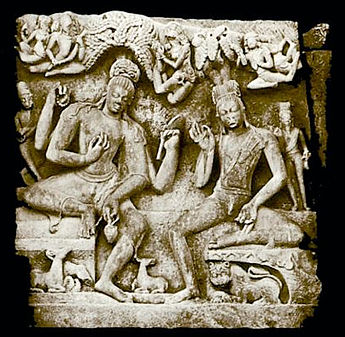Nara-Narayana
Nara-Narayana (Sanskrit: नर-नारायण; nara-nārāyaṇa) is a Hindu deity pair. Nara-Narayana is the twin-brother avatar of the God Vishnu on earth, working for the preservation of dharma or righteousness. In the concept of Nara-Narayana, the human soul Nara is the eternal companion of the Divine Narayana.
The Hindu epic Mahabharata identifies the God Krishna (an avatar of Vishnu) with Narayana and Arjuna - the chief hero of the epic - with Nara. The legend of Nara-Narayana is also told in the scripture Bhagavata Purana. Hindus believe that the pair dwells at Badrinath, where their most important temple stands.
The name "Nara-Narayana" can be broken into two Sanskrit terms, Nara and Narayana. Nara means human, and Narayana refers to the name of the deity.
Monier-Williams dictionary says Nara is "the primeval Man or eternal Spirit pervading the universe (always associated with Narayana, "son of the primeval man"; both are considered either as gods or sages and accordingly called देवौ, ऋषी, तापसौ. In epic poetry, they are the sons of Dharma by Murti or Ahimsa and emanations of Vishnu, Arjuna being identified with Nara, and Krishna with Narayana.- Mahabharata, Harivamsa and Purana".
In a previous life, the duo were born as the sages Nara and Narayana, and who performed great penances at the holy spot of Badrinath. Nara and Narayana were the Fourth Avatar of Lord Vishnu. The twins were sons of Dharma, the son of Brahma and his wife Murti (Daughter Of Daksha) or Ahimsa. They live at Badrika performing severe austerities and meditation for the welfare of the world. These two inseparable sages took avatars on earth for the welfare of mankind. Legend has it that once Lord Shiva tried to bring the fame of Nara and Narayana before the entire world. To do that, he hurled his own potent weapon Paashupathastra at the meditating Rishis. The power of their meditation was so intense that the astra lost its power before them. Lord Shiva stated that this happened since the duo were Jnanis of the first order constantly in the state of Nirvikalpa Samadhi.
The Bhagavata Purana tells the story of the birth of Urvashi from the sages Nara-Narayana. Once, sages Nara-Narayana were meditating in the holy shrine of Badrinath situated in the Himalayas. Their penances and austerities alarmed the gods, so Indra, the King of Devas, sent Kamadeva, Vasanta (spring) and Apsaras (nymphs) to inspire them with passion and disturb their devotions. The sage Narayana took a flower and placed it on his thigh. Immediately there sprung from it a beautiful nymph whose charms far excelled those of the celestial nymphs, and made them return to heaven filled with shame and vexation. Narayana sent this nymph to Indra with them, and from her having been produced from the thigh (Uru in Sanskrit) of the sage, she was called Urvashi.
